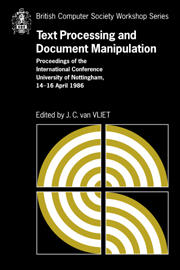 Text Processing and Document Manipulation
Text Processing and Document Manipulation Published online by Cambridge University Press: 05 May 2010
ABSTRACT
This paper describes the BIOSTATION, a generalized document preparation system, developed to guide an interactive editing of biological sequences by taking into account their semantics. This paper also focusses on the use of a document preparation system as the mediator for a larger application.
Introduction
The BIOSTATION is a generalized document preparation system, developed for the CRBM** and in use since May 85, able to guide an interactive editing of biological sequences by taking into account their semantics. This semantic is extracted at editing time from the document itself by an integrated expert system, and is used to express the structuration. This paper also focusses on the use of a document preparation system as the mediator for a larger application.
Genetic sequences are observed in this approach as generalized documents. This choice allows to associate convenient, and so more legible, visual representations to the abstract aspects of biological sequences semantic.
At first, we explain how semantic information on the sequences is obtained and used to guide editing. The biostation architecture is presented in a second section.
Problem position
The genetic information which allows organic cells to synthesize proteins is kept in genes. These genes are linear strings built with four types of molecules (Adenin, Thymin, Guanin, Cytosin) called nucleotids. The non biologist readers can refer to [Hélène 84]. The studied length of such strings can be up to 30000 atoms.
A gene can be analysed by the biologists to explicit its formula as a word on (A, T, G, C), and operations can be done on the gene (in vitro or in vivo) to modify it by insertions or deletions of some parts, at precise positions.
To save this book to your Kindle, first ensure [email protected] is added to your Approved Personal Document E-mail List under your Personal Document Settings on the Manage Your Content and Devices page of your Amazon account. Then enter the ‘name’ part of your Kindle email address below. Find out more about saving to your Kindle.
Note you can select to save to either the @free.kindle.com or @kindle.com variations. ‘@free.kindle.com’ emails are free but can only be saved to your device when it is connected to wi-fi. ‘@kindle.com’ emails can be delivered even when you are not connected to wi-fi, but note that service fees apply.
Find out more about the Kindle Personal Document Service.
To save content items to your account, please confirm that you agree to abide by our usage policies. If this is the first time you use this feature, you will be asked to authorise Cambridge Core to connect with your account. Find out more about saving content to Dropbox.
To save content items to your account, please confirm that you agree to abide by our usage policies. If this is the first time you use this feature, you will be asked to authorise Cambridge Core to connect with your account. Find out more about saving content to Google Drive.